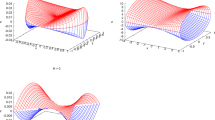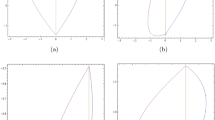Abstract
In this paper, we discuss J. Bernoulli’s brachistochrone problem and find its analytical and numerical solutions in the cases where viscous or dry friction are taken into account. We predict the existence of a point of “geometrical phase transition” u0 = ln(1/2k2b); it corresponds to the transition from one class of trajectories to another that qualitatively differs from the initial class. Numerical simulation of the motion in a neighborhood of points of geometric phase transitions is performed. We prove that in the absence of friction forces, the minimization problem for the motion time for any motion along a curvilinear trough under the action of the gravity force can always be reduced to the brachistochrone problem and can be solved without involving methods of calculus of variation, only by general dynamical laws. We find a solution to the classical Bernoulli problem under the condition that the length of the trajectory is fixed. We show that under this isoperimetric condition, the class of trajectories differs from the classical brachistochrone. We also observe the transformation of these trajectories to the cycloid by numerical and analytical analysis.
Similar content being viewed by others
References
S. O. Gladkov, Problems in Theoretic and Mathematical Physics [in Russian], Fizmatlit, Moscow (2006).
H. B. Dwight, Tables of Integrals and Other Mathematical Data, Macmillan, New York (1961).
L. D. Landau and E. M. Lifshits, Hydrodynamics, Nauka, Moscow (1988).
G. M. Fikhtengol’tz, A Course of Differential and Integral Calculus [in Russian], Nauka, Moscow (1965).
M. V. Shamolin, “Dynamical systems with variable dissipation: Methods and applications,” Fundam. Prikl. Mat., 14, No. 3, 3–237 (2008).
L. E. El’sgol’tz, Differential Equations and Calculus of Variations [in Russian], Nauka, Moscow (1969).
L. C. Young, Lectures on the Calculus of Variations and Optimal Control Theory, Saunders, Philadelphia–London–Toronto (1969).
Author information
Authors and Affiliations
Corresponding author
Additional information
Translated from Itogi Nauki i Tekhniki, Seriya Sovremennaya Matematika i Ee Prilozheniya. Tematicheskie Obzory, Vol. 145, Geometry and Mechanics, 2018.
Rights and permissions
About this article
Cite this article
Gladkov, S.O., Bogdanova, S.B. Analytical and Numerical Solution of the Problem on Brachistochrones in some General Cases. J Math Sci 245, 528–537 (2020). https://doi.org/10.1007/s10958-020-04709-0
Published:
Issue Date:
DOI: https://doi.org/10.1007/s10958-020-04709-0
Keywords and Phrases
- numerical simulation
- brachistochrone
- dissipative function
- instantaneous coordinate system
- geometric phase transition
- isoperimetric condition




